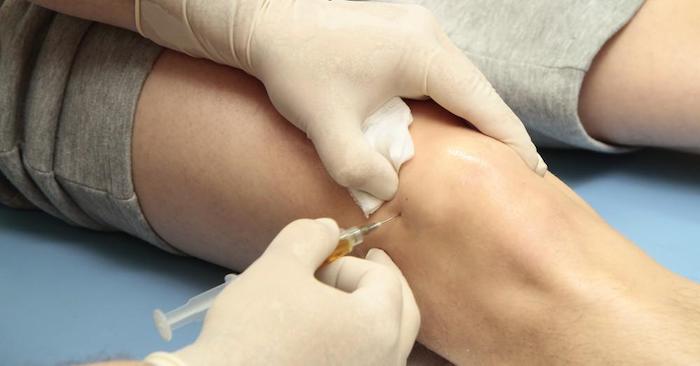
The underlying theory behind PRP or platelet-rich plasma therapy treatments is derived from the body naturally healing itself. The body’s first line of defense when injured is to send platelets to the tissue or target area. Platelets promote healing which is exactly what PRP therapy injections can do.
A Quick Primer on PRP Therapy and What It Is
Our blood carries plasma which is rich with regenerative components like platelets that assist the body in naturally healing or repairing damaged tissue. PRP, or platelet-rich plasma, therapy uses a person’s plasma agents to build-up areas, such as the joints, that are diseased or injured. This regenerative therapy treatment provides men and women with an alternative way to stay pain-free, more active, and without the need for joint replacement surgery.
PRP therapy requires no general anesthesia. The process involves a simple blood draw to create the PRP which is injected back into the body. The patient’s blood is put into a centrifuge to process and separate the rich plasma platelets. When ready, it is injected into problem areas such as the shoulders, knees, or ankles to alleviate pain and discomfort.
Here are 10 reasons why PRP therapy treatments are used in the medical community today and how they can help get you back to feeling pain-free.
10 Reasons Why PRP Therapy Is Used in Medicine
High Profile Therapy
PRP therapy injections got some popular buzz after athletes began using this treatment option to help with their sports-related injuries. Top athletes like Tiger Woods, Hines Ward, and others have claimed to heal faster and be back at their game quicker thanks to PRP therapy treatments.
Convenient Resource
Every patient has a blood supply that can be utilized for this type of therapy treatment. Our blood contains platelets, which are blood cells that are the driving force behind your body forming blood clots. Comprised of proteins that regulate new growth allowing your body to heal, PRP therapy relies on these platelets to speed up the healing process which is conveniently located within our bodies.
Natural Healing
PRP therapy injections are comprised of a high concentration of extracted platelets rich in plasma which promotes an increase in the number of reparative cells that flood the target area. PRP injections make sense in that it aids in giving the body more of its natural resource in a concentrated setting to reduce pain, swelling, stiffness, and promote healing.
Simple Process
Patients only have to donate their blood to consider PRP therapy treatments. This simple process takes only a couple of vials to be processed in a centrifuge to separate the blood into various categories. The platelets are concentrated together and then extracted to be used for the injections.
Regenerative Therapy for Joint Pain
There are multiple areas of the body that PRP injections can help. Joint pain caused by arthritis, osteoarthritis, an injury, or the natural process of aging is a prime target for PRP therapy. Board-certified medical doctors and pain specialists can provide PRP injections to alleviate any joint pain virtually anywhere on the body. When directly injected into joints, PRP treatments can reduce pain, swelling, improve functionality or range of motion, and in some cases, help repair cartilage damage.
A Precise Treatment
With guided fluoroscopy or ultrasound technology, PRP therapy injections can be precisely placed by a board-certified medical professional to localize the problem and begin the process of regenerating new growth or healing. Platelet-rich plasma can be collected and injected into an injured or damaged joint, bone or soft tissue, tendon, ligament, or disc.
Quick Procedure
PRP injections typically only take about 30 minutes. This quick and easy procedure allows patients to return to work or other normal daily activities immediately after the treatment. There may be some slight swelling or soreness at the injection site but it will only last a few days.
Low-Risk Factors
One of the great benefits of this type of treatment is that no general anesthesia is required. A local anesthetic will be used to allow for minimal discomfort. Another great aspect of PRP therapy treatment is the low-risk factors. Using a patient’s blood supply for its healing component of platelets leads to virtually no risk of infection and no risk of rejection.
The Results Are In
Studies have shown definitive tissue repair is present after PRP therapy treatments. Complete pain relief is not usually an immediate result after the first injection, but chronic pain can be significantly reduced. PRP therapy sets the repairing mechanism in motion so that after several weeks or another follow-up treatment patients start to get pain relief. Often patients will need multiple injections every 2-3 months to optimize the results.
Medical Help in Other Areas
In earlier years of using PRP therapy injections, doctors used it to promote faster healing after plastic surgery procedures or other types of dermatological issues such as scar reduction. Today, PRP therapy is the hot new treatment for restoring hair loss. PRP therapy injections target balding or thinning spots, encouraging existing hair follicles to grow to leave patients with fuller, thicker hair as a result. There is mounting evidence that PRP therapy is decreasing hair loss and increasing the thickness of existing hair which has got people talking.
The definitive medical results and patient accolades about this type of therapy say it all — PRP treatments work. To avoid invasive surgery or deal with daily chronic pain, PRP therapy injections are helping individuals.
Precision Pain Care and Rehabilitation has two convenient locations in Richmond Hill – Queens and New Hyde Park – Long Island. Call the Richmond Hill office at (718) 215-1888, or (516) 419-4480 for the Long Island office, to arrange an appointment with our Interventional Pain Management Specialist, Dr. Jeffrey Chacko.















